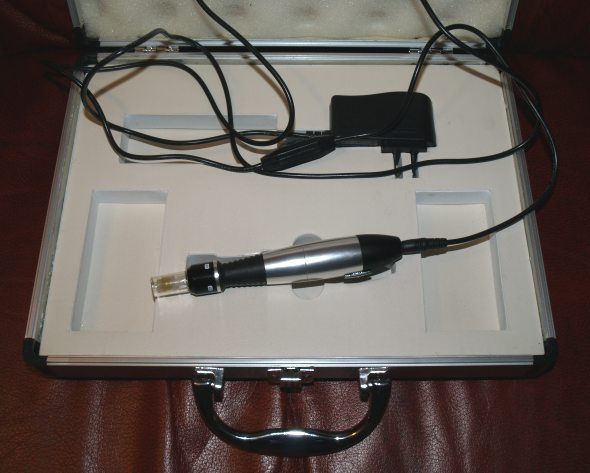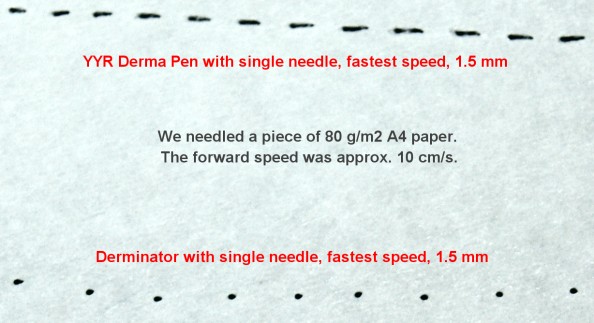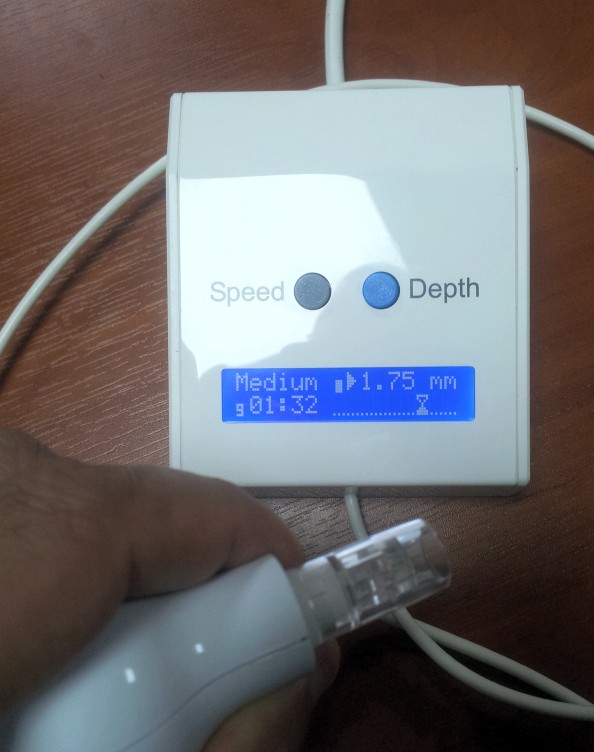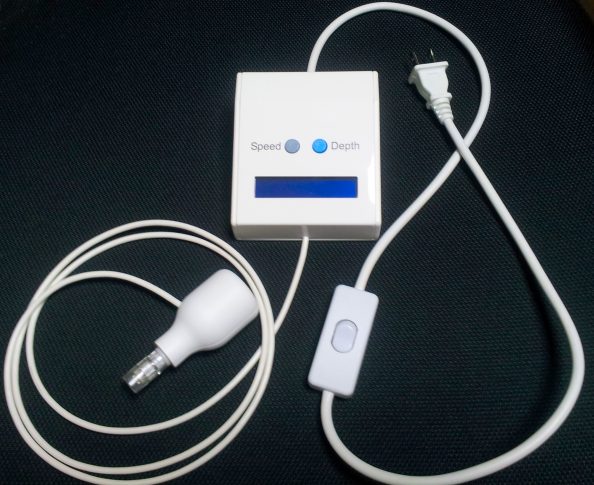Derma-"pen" review
A few years ago, we investigated the idea of creating our own "automatic" microneedling device.
Because an ordinary tattoo machine is too harsh on the skin, as it deeply penetrates the skin 50 or 60 times a second (depending on your mains frequency). So our idea was to design a machine that would needle much slower (at least ten times slower, a bit like like a sewing machine) and have a set of needles instead of just one. After some experimentation and brainstorming, we came to the conclusion that this was not an easy task. Practical design considerations required a needling speed equal to the mains frequency (50 or 60 Hz). But that would be too fast for optimal results in our opinion, and moreover, it would require enormous power if you'd want to drive a dozen needles into the skin simultaneously. On top of that comes the "duty cycle" problem, the problem that you can only allow the needles into the skin for a small percentage of the time, or risk skin tearing when the dermapen is moved over the skin. A slow-moving, powerful needling machine with a very short duty cycle and multiple needles would cost a lot of money and be heavy to handle.
However, there have been a lot of such devices offered for sale lately, so we bought one and tested it:

This is not the Dermapen® brand (because we found no way on their site to purchase one) but a similar device. This device looks very similar, is based on the same principle and uses similar components. This device claims to needle to a maximum depth of 1 mm, but we found it nearly impossible to penetrate the skin. This is due to the "Fakir effect", which needs strong force to overcome it, which this device can't muster. We had to press hard onto the skin at the maximum power setting to get some redness occurring, and that only on the inside of the wrist and other such places. The device, with a suggested retail price of hundreds of dollars, did not come with a European power plug or even a user manual. Its manufacturer spent a great deal of effort making the thing look expensive - it comes in a fancy case - but the device itself is of poor quality. Rotating knobs have a stuck feeling to them and the device feels like a cheap plastic gadget. The chrome looking part is made of plastic. The switch halfway the cord does something to the speed or power of the device - we were unable to ascertain exactly what, as on no setting it properly penetrated the skin.
We think that the concept is interesting but we will not purchase other such devices to test because firstly, we'd have to pay hundreds of dollars per model and secondly, we do not believe that the other models have a significantly better performance. The problem is that in order to drive twelve needles through the skin, you'd need a lot of force. To do this fifty times a second requires a lot more force than a light, thin device can muster. So these devices, in spite of the needle lengths of up to 2 mm, don't actually push their needles that deep into the skin. The pen-needler would have to be much heavier for the electromagnet to be able to be that strong. And even if the needles would have been able to deeply penetrate the skin, there would be the risk of skin micro-tearing, due to the fact that you will inevitably move the needles sideways through the skin while they are inside the skin. We explain exactly why a very short "duty cycle" is required to avoid this damage here: /dermarolling/dermapen-causes-skin-micro-tearing/
Spare needle heads are very expensive, so needling costs about the same as with a dermaroller or dermastamp. One spare needle head has a suggested retail price that comes close to the price of the dermastamp we sell. They are sold in bulk to companies like us for a couple of dollars a piece, but as it is in this business, most vendors are only interested in cold, hard cash and will charge outrageous prices, as usual.
One of our concerns with such devices is that they may tear the skin, when not expertly operated. When working as advertised, its 12 needles are "down" into the skin about 50% of the time, 25% quite deeply. Now, with a derma roller, you roll the needles in and out, but with the derma pen, you move the needle head sideways, so the needles will be moved sideways while they are still inside your skin, with no way to get out of the skin until the needle head is pulled upwards again by the machine. This means that if you move the machine too fast, it will cause micro-tearing (lateral shearing) of the skin. And if you move too slowly, it will make too many holes in the skin (50 Hz x 12 needles = 600 a second in Europe and 720 a second in countries with a 60 Hz mains frequency such as the United States). So you need to know exactly how fast to move the device, but that depends on your mains frequency, the make and model of the device, the selected needle length and the electromechanical particulars of the way the needle head moves in and out (the "duty-cycle").
If anyone has purchased a different model that actually works as advertised and does not cost an arm and a leg, we'd be happy to hear about it so we can add it to our assortment. What we are looking for is pinpoint bleeding on the 1.5 or 2 mm setting without the need to push down hard, and preferably a speed that can be regulated to far below the mains frequency. We don't think such devices exist yet. Please - if you mention brands or post links - only do so when you have actually tried it, the product is available for sale to ordinary consumers and has a needle length of at least 1.5 mm. The Eclipse Micropen for example is one of those devices that are just "buzzing" or "vibrating" the needles without sufficient strength to fully penetrate the skin, because the frequency is too high and the power behind it too low. Update: This is what we mean:

Conclusion: Interesting concept but not yet ready for prime time. We'll definitely will start selling them when we can find one that actually works, and when it's reasonably affordable (this one would have to cost $300,- retail). At the moment we decided we can't resell anything that's available for bulk wholesale purchase (all these devices are made in China) because we are certain that a significant percentage of customers would want their money back. The manufacturer promised that there will be a user manual soon, but dismissed our complaint that the device was too feeble for its intended purpose.
Update of August 2, 2013
For the past couple of months we have been selling the DermaJet auto-needler and we initially were very enthousiastic about the device because it implemented our idea of using an electromagnet. A sample we were sent by the Turkish manufacturer performed well. However, the actual batch of 300 devices we purchased had such a high failure rate that we had to stop selling the DermaJet. Our remaining stock will be used to replace broken devices.
Meanwhile we keep testing the available devices, and so far we have not found a good one. Especially the AMTS-H causes extreme microtearing.
Update of November 18, 2013
We are developing our own, very advanced dermaneedling machine which we hope to launch late summer 2014. The Derminator (store page). The Derminator has such a short duty cycle that it does not cause microtearing. This page has detailed info on the Derminator.



















